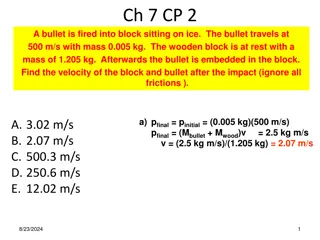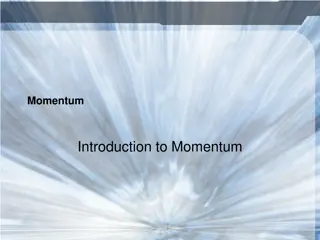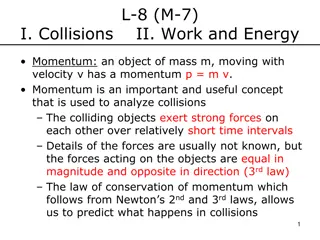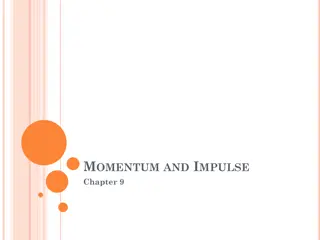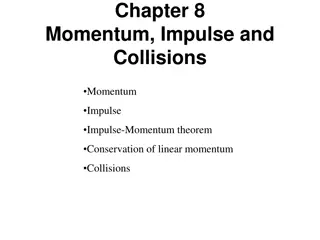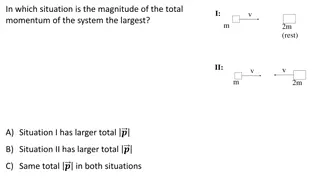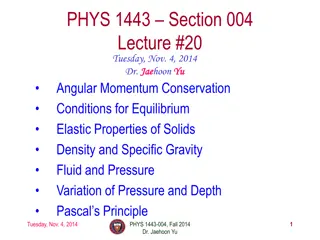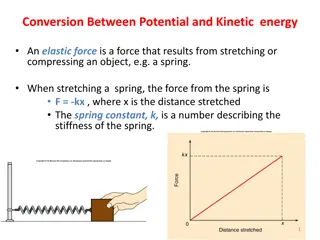Momentum Concept iClicker Questions
Explore momentum concepts through iClicker questions related to kinetic energy, momentum of systems, and the relationship between momentum and kinetic energy in systems of particles. Understand the implications of zero kinetic energy and momentum in different scenarios.
Download Presentation

Please find below an Image/Link to download the presentation.
The content on the website is provided AS IS for your information and personal use only. It may not be sold, licensed, or shared on other websites without obtaining consent from the author. Download presentation by click this link. If you encounter any issues during the download, it is possible that the publisher has removed the file from their server.
E N D
Presentation Transcript
Continuing Chapter 7 (Momentum) ----- First some momentum concept (iClicker) questions 1
ConcepTest 7.2a Momentum and KE I A system of particles is known to have a total kinetic energy of zero. What can you say about the total momentum of the system? a) momentum of the system is positive b) momentum of the system is negative c) momentum of the system is zero d) you cannot say anything about the momentum of the system 2
ConcepTest 7.2a Momentum and KE I A system of particles is known to have a total kinetic energy of zero. What can you say about the total momentum of the system? a) momentum of the system is positive b) momentum of the system is negative c) momentum of the system is zero d) you cannot say anything about the momentum of the system Since the total kinetic energy is zero, this means that all of the particles are at rest (v = 0). Therefore, since nothing is moving, the total momentum of the system must also be zero. 3
ConcepTest 7.2b Momentum and KE II A system of particles is known to have a total momentum of zero. Does it necessarily follow that the total kinetic energy of the system is also zero? a) yes b) no 4
ConcepTest 7.2b Momentum and KE II A system of particles is known to have a total momentum of zero. Does it necessarily follow that the total kinetic energy of the system is also zero? a) yes b) no Momentum is a vector, so the fact that ptot = 0 does not mean that the particles are at rest! They could be moving such that their momenta cancel out when you add up all of the vectors. In that case, since they are moving, the particles would have non-zero KE. 5
ConcepTest 7.2b Momentum and KE II A system of particles is known to have a total momentum of zero. Does it necessarily follow that the total kinetic energy of the system is also zero? a) yes b) no = + = 0 total p p p 1 2 1p 2 p 2 1 6
Two boxes, one heavier than the other, are initially at rest on a horizontal frictionless surface. The same constant force F acts on each one for exactly 1 second. Which box has more momentum after the force acts? a) the heavier one b) the lighter one c) both the same F F heavy light 7
Two boxes, one heavier than the other, are initially at rest on a horizontal frictionless surface. The same constant force F acts on each one for exactly 1 second. Which box has more momentum after the force acts? a) the heavier one b) the lighter one c) both the same F F heavy = F t p light net 8
In the previous question, a) the heavier one which box has the larger b) the lighter one velocity after the force acts? c) both the same 9
In the previous question, a) the heavier one which box has the larger b) the lighter one velocity after the force acts? c) both the same The force is related to the acceleration by Newton s 2nd Law (F = ma). The lighter box therefore has the greater acceleration, and will reach a higher speed after the 1-second time interval. 10
In the previous question, a) the heavier one which box has the larger b) the lighter one velocity after the force acts? c) both the same = = F m heavy a m light a heavy light 11
ConcepTest 7.14a Recoil Speed I a) 2 m/s b) 6 m/s c) 9 m/s d) 12 m/s e) 18 m/s Amy (150 lbs) and Gwen (50 lbs) are standing on slippery ice and push off each other. If Amy slides at 6 m/s, what speed does Gwen have? 50 lbs 150 lbs 12
ConcepTest 7.14a Recoil Speed I a) 2 m/s b) 6 m/s c) 9 m/s d) 12 m/s e) 18 m/s Amy (150 lbs) and Gwen (50 lbs) are standing on slippery ice and push off each other. If Amy slides at 6 m/s, what speed does Gwen have? The initial momentum is zero, so the momenta of Amy and Gwen must be equal and opposite. Since p = mv, then if Amy has 3 times more mass, we see that Gwen must have 3 times more speed. 50 lbs 150 lbs 13
ConcepTest 7.14a Recoil Speed I a) 2 m/s b) 6 m/s c) 9 m/s d) 12 m/s e) 18 m/s Amy (150 lbs) and Gwen (50 lbs) are standing on slippery ice and push off each other. If Amy slides at 6 m/s, what speed does Gwen have? = m ( ) ( ) 150 6 50 lbs lbs v Gwen sec 150 50 lbs lbs m = 6 Gwen v sec m = 18sec Gwen v 50 lbs 150 lbs 14
ConcepTest 7.16a Crash Cars I a) I b) II c) I and II d) II and III e) all three If all three collisions below are totally inelastic, which one(s) will bring the car on the left to a complete halt? 15
ConcepTest 7.16a Crash Cars I a) I b) II c) I and II d) II and III e) all three If all three collisions below are totally inelastic, which one(s) will bring the car on the left to a complete halt? In case I, the solid wall clearly stops the car. In cases II and III, since ptot = 0 before the collision, then ptot must also be zero after the collision, which means that the car comes to a halt in all three cases. 16
Consider a ball that collides with a tall block During collision: block onball F ball onblock F = block onball F ball onblock F 3rd law says: 19
Consider a ball that collides with a tall block v The block might get knocked over 20
Look at just the ball The force acts for a short time t block onball F 23
Look at just the block The force acts for a short time t ball onblock F 27
Look at just the block The block might be knocked over 28
Set up a superball to collide with a block so that the block just barely falls over 29
What will happen if you replace the bouncy superball with a lump of clay of the same mass? Let us assume that the duration of the collision is the same in both cases Will the block be knocked over? 30
What will happen if you replace the bouncy superball with a lump of clay of the same mass? Let us assume that the duration of the collision is the same in both cases Will the block be knocked over? 31
Superball versus clay ball: What is different in the two cases? p of the balls is different! final Clay ball: Superball: inital p inital p p p final final superball p = p initial p clay ball p = p initial p final final superball p clay ball p Therefore: 33
Superball versus clay ball: What is different in the two cases? p of the balls is different! final superball p clay ball p superball p clay ball p = = F t p J t t block on superball F block on clay ball F block on superball F block on clay ball F 34
block onball F ball onblock F block on superball F block on clay ball F By the 3rd law: superball on block F clay ball on block F so this force, being smaller in magnitude, isn t big enough to knock the block over This force just barely knocks the block over 35
Center of mass We have been idealizing objects as point particles Began to talk about systems of particles (collisions) Given an extended object, where would you locate the idealized point particle? At the center of mass 37
Center of mass: a location It s the mass-weighted average position of all the particles that make up the system m y 2 Case 1: A discrete group of point masses m 1 3x 1x 2x m x 3 + + + m x m x m + m x m = 1 1 2 2 3 3 + x cm + m 1 2 3 38
Center of mass: a location It s the mass-weighted average position of all the particles that make up the system m y 2 Case 1: A discrete group of point masses m 1 x m x cm 3 + + + m x m x + m x m = 1 1 2 2 m 3 3 + x cm + m 1 2 3 39
Center of mass: a location It s the mass-weighted average position of all the particles that make up the system m y 2 Case 1: A discrete group of point masses y m cm CM 1 x m x cm 3 + + + m y m y m + m y m = 1 1 2 2 3 + 3 y cm + m 1 2 3 40
Center of mass: a location Case 2: A continuous and uniform mass distribution y CM x You could balance the object by supporting it at the center of mass 41
Center of mass: a location Case 2: A continuous and uniform mass distribution y CM x The center of mass need not be located inside the object! 42
Newtons second law for a system of particles = F ma net cm The sum of all the forces is equal to the total mass of the system times the acceleration of its center of mass This can be written: = external F ma cm 44
Something interesting: We have the ability to move the location of the CM of our bodies relative to our bodies. How? By moving, especially our arms & legs High jumpers, basketball players, and ballerinas 46
The Fosbury flop http://www.youtube.com/watch?v=_bgVgFwoQVE http://www.youtube.com/watch?v=cri_yhTFmX0 http://www.youtube.com/watch?v=Id4W6VA0uLc 48










